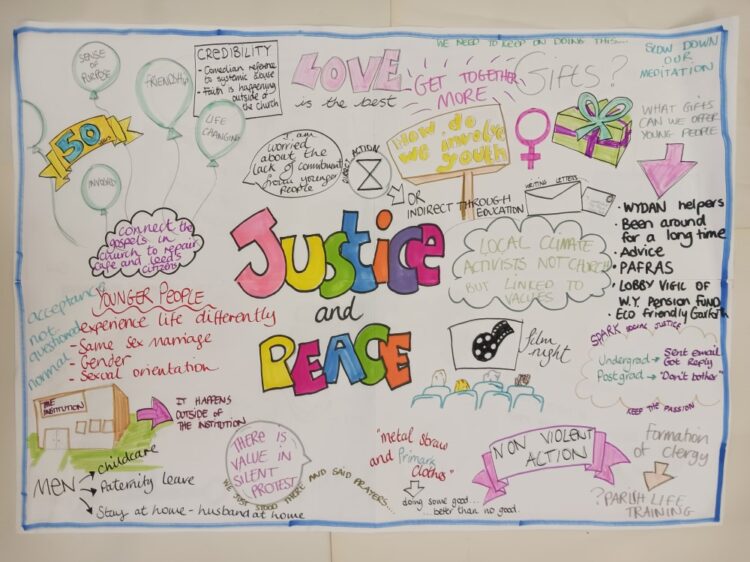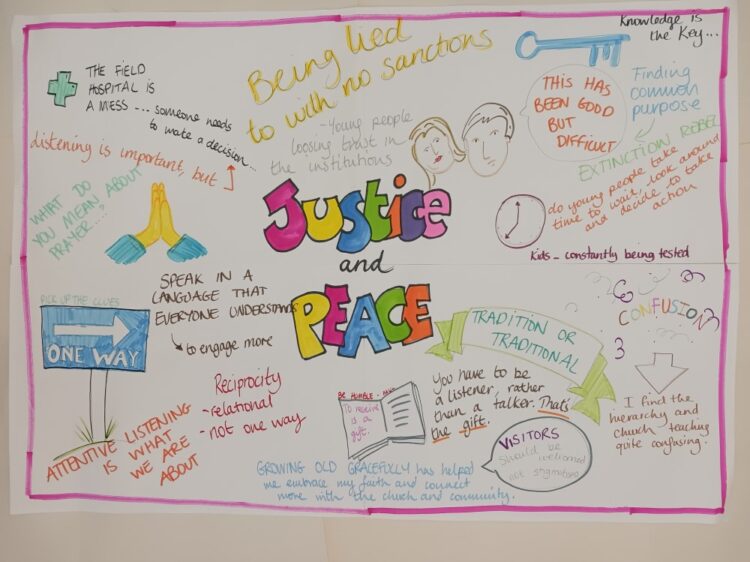Introduction
By Matty Maslen, Newsletter Editor; Sara Forrest, Commission member; and Bronagh Daly, Faith and Creativity Lead at LCI.
At the end of last year, we held an event at Wheeler Hall in Leeds. The title was ‘Listening to the Signs of the Times’.
To begin the event, John Battle read a prayer which called for the Lord to “come set our hearts ablaze with hope”. He then gave a short introduction to the day ahead.
He outlined the three main challenges currently facing the commission:
1. Engagement 2. Realistic Action 3. Capacity
John asked us to keep these in mind as we engaged in our group discussions. We were split into groups and allocated to a table where there were a number of A3 sheets of paper awaiting us, each of which had a different question for us to discuss.
Each of these questions tied into one of the three main challenges John had outlined, and as the prayer he had read out at the beginning asked, encouraged us to be hopeful in overcoming them.
Below, we’ve collated some reflections from attendees:
Sara's Reflection
My group of four were born in different decades and had lived in three continents. The guided questions took us to a place of deep listening and meaningful discussion.
Our interests were different – environment, corruption, poverty. We were united by a belief that Jesus calls us to love and care for the world. We agreed our world needs healing. And that media reports tend to oversimplify complex situations. ‘Solutions’ tend to be based on ‘us or them’, winners and losers. We felt called to make a difference but were unsure how to go about it.
We identified locally led change as effective, but it is often unreported and hard to find. You have to look for it because algorithms chase hits/likes/shares, they favour big organisations. Change that is just succeeds because it is born of including the marginalised. It is practical, often small scale. When other people see it works, they are more likely to change too.
Lunch provided an opportunity to mix with other participants. It was so good to be with working age people!
There was a real spirit of sharing and common purpose. I felt reassured that other people were also looking to express their faith through action and look forward to the next event.
Bronagh's Reflection
I have been a steering group member of SPARK Social Justice for several years, and the creativity built into the delivery model has untapped potential. Bringing young people together to share their ideas, passions and concerns about inequality and social justice through drama, discussion and video content offers a new way to promote dialogue for change.
Ahead of a SPARK youth leadership event, held at Leeds Trinity University on 4th October 2024, I joined the planning meeting and offered to be the graphic note taker for the day. As the Faith and Creativity Lead at Leeds Church Institute, my role is to utilise the visual arts to support Christians, churches and faith organisations to learn for a faithful city.
This creative way of making notes involves listening in a different way. It was very hard to resist joining in the conversation, as I would normally do. I stayed almost completely silent and listened with intent to a wide range of viewpoints and ideas. My aim was to capture the spoken word not just in note form as we see at so many workshops, but to create a more dynamic record of the words that are spoken, almost as the throw-aways.
I recorded images of a pizza being shared, a member of clergy mentioned this as an example of taking turns and a tool used in chaplaincy to bring young people together for discussion.
I delved into the etymology of the word ‘conscience’, a word integral to the teaching of St Thomas of Acquinas that I heard a retired lecturer mention.
I drew a fizzy drink, mentioned by a young person who decided to cut it out in his quest to be a ‘good disciple’ and live a more simplistic and wholesome life.
A doodle of a gift, wrapped up with a red bow, created a focal point for more in-depth conversations when someone talked about how important their gifts are but sometimes go unnoticed. Students expanded on the ‘gift’ idea and talked about the link the gifts of the holy spirit have with their desire for a change to the way young people from marginalised groups are increasingly being welcomed into the university union as reps and ambassadors.
The amalgam of doodles, typography and symbols across the 3 pages offered a new dynamic to the workshops. I reflected on our primordial need as humans to leave a mark. Just as the paint blown against hands in the Gargas Caves 14,000 years ago, the earliest mark making recorded we left a mark that we came together, we created a visual representation of over 40 people coming together to record the hopes and aspirations of young people and their desire to one day become leaders in social justice.
Before the Victorian era, many Christians were illiterate. Stained glass windows in churches and carvings in wood or stone helped to communicate the Good News of the gospels and offered instruction for salvation. Our graphic notetaking follows in that tradition. We connected through a combination of imagery and words, colour and space.
Something special happens to our spirit when we connect with the visual arts. Paintings and photographs can help convey emotions that are often failed by the written word, we are in the main visual learners. Drawing on the art of listening, slowing down the note-taking process to pictorial form takes time. Representing the spoken word as image takes courage. When we share our wisdom in visual form, we connect across languages and cultures.
This intergenerational gathering engaged in the graphic note taking methodology and embraced it with ease. Graphic note taking offered revelation and intrigue.
The images are long lasting and, in a way, become sacred. We hold images differently to how we hold workshop notes in written form. I have been informed that the images we created will be utilised as either a learning resources, or pleasant backdrop for future SPARK Social Justice events. The illustrations of the conversations I created will act as a visual shortcut offering the didactic message of ‘Lead, Empower and Change’ to as wider audience and help to promote the visual arts as a conduit for learning as a faithful city.
Matty's Reflection
As the youngest attendee, I really enjoyed the intergenerational discussions that the event fostered. It can often be difficult to find the spaces to talk to people outside our own bubbles, be that age-related, ideology-related, lived-experiences, or otherwise.
In the group I was in, this fed into the discussions we held. We talked about the role of the clergy in empowering and encouraging us to bring about meaningful social change.
When we reached the stage of the day where we were asked to sum up our group discussions in 3 words, we first allowed everyone to choose a word to see if we had any common themes. Inevitably, there were: ‘dialogue, broadening, and bridge-building’ were all mentioned. This notion of stepping outside our own perspectives has been my key take-away from the day.
As John Battle had said to us right at the start: “deeper listening all the time” – and we cannot be truly listening if we are simply waiting for our turn to talk.


